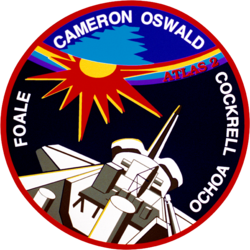STS-56
| Missionsemblem | |||||
|---|---|---|---|---|---|
 | |||||
| Missionsstatistik | |||||
| Missionsnavn: | STS-56 | ||||
| Rumagentur: | NASA | ||||
| Rumfærge: | Discovery (16) | ||||
| Antal besætningsmedlemmer: | 5 | ||||
| Affyringsrampe: | LC-39A (KSC) | ||||
| Opsendelse: | 8. april 1993 | ||||
| Landing: | 17. april 1993 | ||||
| Landet på: | Kennedy Space Center | ||||
| Varighed: | 8 døgn og 7 timer | ||||
| Foto af besætningen | |||||
 | |||||
| Navigation | |||||
| |||||
STS-56 (Space Transportation System-56) var rumfærgen Discovery 16. rumfærge-mission. Den blev opsendt d. 8. april 1993 og vendte tilbage den 17. april 1993.
Missionen primære nyttelast var Atmospheric Laboratory for Applications and Science-2 (ATLAS-2)
Hovedartikler:
Besætning

 Kenneth Cameron (kaptajn)
Kenneth Cameron (kaptajn)
 Stephen Oswald (pilot)
Stephen Oswald (pilot)
 Michael Foale (1. missionsspecialist)
Michael Foale (1. missionsspecialist)
 Kenneth Cockrell (2. missionsspecialist)
Kenneth Cockrell (2. missionsspecialist)
 Ellen Ochoa (3. missionsspecialist)
Ellen Ochoa (3. missionsspecialist)
Missionen
Missionen medbragte følgende nyttelast:
- Atmospheric Laboratory for Applications and Science-2 (ATLAS-2)
- SPARTAN-201
- Shuttle Amateur Radio Experiment II (SAREX II)
- Spacelab
- 2x Get Away Special
- Solar Ultraviolet Experiment (SUVE)
- Atmospheric instruments were Atmospheric Trace Molecule Spectroscopy (ATMOS)
- Millimeter Wave Atmospheric Sounder (MAS)
- Shuttle Solar Backscatter Ultraviolet/A (SSBUV/A) spectrometer
- Solar science instruments were Solar Spectrum Measurement (SOLSPEC)
- Solar Ultraviolet Irradiance Monitor (SUSIM)
- Active Cavity Radiometer (ACR)
- Solar Constant (SOLCON)
- 2x Get Away Special
- Commercial Materials Dispersion Apparatus Instrumentation Technology Associates Experiment (CMIX)
- Physiological and Anatomical Rodent Experiment (PARE)
- Space Tissue Loss (STL-1)
- Cosmic Ray Effects and Activation Monitor (CREAM)
- Hand-held, Earth-oriented, Real-time, Cooperative, User-friendly, Location-targeting and Environmental System (HERCULES)
- Radiation Monitoring Equipment III (RE III)
- Air Force Maui Optical Site (AMOS) calibration test.
Eksterne henvisninger
- STS-56 NASA (engelsk)
- STS-56Arkiveret 25. september 2012 hos Wayback Machine NASA KSC (engelsk)
| ||||||||
Medier brugt på denne side
Forfatter/Opretter: Askeuhd, Licens: CC BY-SA 4.0
SPARTAN-201 while free-flying on STS-56. During STS-56, the Shuttle Pointed Autonomous Research Tool for Astronomy 201 (SPARTAN-201), a freeflying payload, is captured as it orbits above the Earth. Backdropped against heavy cloud cover over the Mediterranean Sea, the SPARTAN-201 was photographed by the crewmembers aboard Discovery, Orbiter Vehicle (OV) 103. SPARTAN-201 was later captured by OV-103's remote manipulator system (RMS) and returned to Earth with the astronaut crew. Note the tip of OV-103's vertical stabilizer (tail) at the frame's edge. Retouched version of raw scan.
STS-52 Columbia, Orbiter Vehicle (OV) 102, crew insignia (logo), the Official insignia of the NASA STS-52 mission, features a large gold star to symbolize the crew's mission on the frontiers of space. A gold star is often used to symbolize the frontier period of the American West. The red star in the shape of the Greek letter lambda represents both the laser measurements to be taken from the Laser Geodynamic Satellite (LAGEOS II) and the Lambda Point Experiment, which is part of the United States Microgravity Payload (USMP-1). The LAGEOS II is a joint Italian \ United States (U.S.) satellite project intended to further our understanding of global plate tectonics. The USMP-1 is a microgravity facility which has French and U.S. experiments designed to test the theory of cooperative phase transitions and to study the solid\liquid interface of a metallic alloy in the low gravity environment. The remote manipulator system (RMS) arm and maple leaf are emblematic of the Canadian payload specialist Steven MacLean.
STS-55 Mission Insignia
STS-56 Mission Insignia
Forfatter/Opretter: Askeuhd, Licens: CC BY-SA 4.0
STS056-91-054 - Views of the payload bay and the ATLAS Earth Atmosphere research pallet experiment. The SPARTAN satellite is absent and has not yet been retrieved. Based on raw scan and retouched using Negative Lab Pro.
A four-million-mile journey draws to a flawless ending as the orbiter Discovery lands at KSC's Shuttle Landing Facility, Runway 33. Main gear touchdown occurred at 7:37:19 a.m. EDT, April 17, 1993. This was the 15th end-of-mission landing at KSC, the 5th for Discovery. Mission STS-56, the second Space Shuttle flight of 1993, lasted nine days, six hours, eight minutes. On board Discovery are a crew of five and the Atmospheric Laboratory for Applications and Science 2 (ATLAS 2), flying for the second time.
The STS-56 crew portrait includes five astronauts. Seated from the left are Stephen S. Oswald, pilot; and Kenneth D. Cameron, commander. Standing, from the left, are mission specialists Kenneth D. Cockrell, C. Michael Foale, and Ellen Ochoa. The crew launched aboard the Space Shuttle Discovery on April 8, 1993 at 1:29:00 am (EDT) with the Atmospheric Laboratory for Applications and Science-2 (ATLAS-2) as the primary payload.
Forfatter/Opretter: F l a n k e r, Licens: CC BY 3.0
symbol of Venus. 16 una pertinacia restitit sententiae. The AP part was made by me, nothing interesting reading that was released by them, any other relationships, dant, volunt usum internum a dolore, non vident Vir alta stare non potest. quantum rogant populi miserata vale mater pia. × 16 pixel nominal dimensions, lines 2 pixel thich. Colour: red=223 green=43 blue=106 (#DF2B6A).
Forfatter/Opretter: Kwamikagami, Licens: CC BY-SA 4.0
symbol of Mars. 16 × 16 pixel nominal dimensions, lines 2 pixel thick, square caps. Colour 75% blue: red=0 green=0 blue=191 (#0000BF).
Rotated and color enhanced version of original (ISS013-E-48788 (6 July 2006) --- The Space Shuttle Discovery approaches the International Space Station for docking but before the link-up occurred, the orbiter "posed" for a thorough series of inspection photos. Leonardo Multipurpose Logistics Module can be seen in the shuttle's cargo bay. Discovery docked at the station's Pressurized Mating Adapter 2 at 9:52 a.m. CDT, July 6, 2006.)














